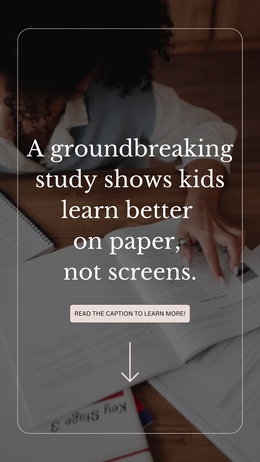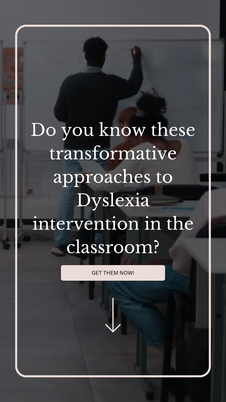Transformative Approaches to Dyslexia Intervention in the Classroom
The research paper "Identifying and Intervening with Beginning Readers Who Are At Risk for Dyslexia: Advances in Individualized Classroom Instruction" underscores the critical importance of identifying and intervening with beginning readers who are at risk for dyslexia. Researchers emphasize that early difficulties in learning letters, sounds, and language strongly predict future reading challenges. By accurately identifying at-risk children and providing evidence-based instruction immediately, researchers believe that reading disabilities can be greatly reduced.
Policy initiatives such as Response to Intervention (RTI) aim to address these concerns by allowing for early intervention services for struggling readers. RTI focuses on providing support before students fall further behind their peers, thereby preventing severe discrepancies between reading and cognitive abilities.
While the article acknowledges the optimism surrounding RTI, it also highlights the need for standardized procedures. The authors share their research experience and emphasize the importance of early intervention, particularly in the early grades where research is robust. Additionally, the article discusses the necessity of intervention for older students and addresses implementation issues related to identifying children who require additional support. Overall, the article serves as a call to action for educators to prioritize early intervention and adopt effective strategies to support students at risk for dyslexia.
To get a copy of this research report, click HERE
The research paper "Identifying and Intervening with Beginning Readers Who Are At Risk for Dyslexia: Advances in Individualized Classroom Instruction" underscores the critical importance of identifying and intervening with beginning readers who are at risk for dyslexia. Researchers emphasize that early difficulties in learning letters, sounds, and language strongly predict future reading challenges. By accurately identifying at-risk children and providing evidence-based instruction immediately, researchers believe that reading disabilities can be greatly reduced.
Policy initiatives such as Response to Intervention (RTI) aim to address these concerns by allowing for early intervention services for struggling readers. RTI focuses on providing support before students fall further behind their peers, thereby preventing severe discrepancies between reading and cognitive abilities.
While the article acknowledges the optimism surrounding RTI, it also highlights the need for standardized procedures. The authors share their research experience and emphasize the importance of early intervention, particularly in the early grades where research is robust. Additionally, the article discusses the necessity of intervention for older students and addresses implementation issues related to identifying children who require additional support. Overall, the article serves as a call to action for educators to prioritize early intervention and adopt effective strategies to support students at risk for dyslexia.
To get a copy of this research report, click HERE
Science of Reading Focus in Schools
Mountain Mahogany Community School in Albuquerque, New Mexico, embarked on a transformative journey to enhance reading proficiency among its K-8 students. Recognizing the pivotal role of literacy in academic success, the school initiated targeted interventions. Led by Lori Webster, the school director, and Alexandra Wilcox, a trained reading interventionist, the endeavor focused on implementing science-based reading approaches. By prioritizing structured literacy and individualized instruction, the school witnessed a significant rise in reading proficiency, with a notable increase from 32% to 52% within a year.
Central to their success was the school's commitment to professional development. Investing in training teachers in science-based reading strategies demonstrated a commitment to equipping educators with the necessary tools to address students' diverse literacy needs. Moreover, fostering open communication and collaboration with families and the wider school community ensured collective support for students' literacy journeys. As the school continues to evolve, the emphasis remains on refining instructional practices, deepening understanding of structured literacy, and cultivating a culture of continuous improvement. Through dedication and collective effort, Mountain Mahogany Community School exemplifies the transformative impact of evidence-based literacy initiatives on student achievement and holistic development.
Read more HERE.
Mountain Mahogany Community School in Albuquerque, New Mexico, embarked on a transformative journey to enhance reading proficiency among its K-8 students. Recognizing the pivotal role of literacy in academic success, the school initiated targeted interventions. Led by Lori Webster, the school director, and Alexandra Wilcox, a trained reading interventionist, the endeavor focused on implementing science-based reading approaches. By prioritizing structured literacy and individualized instruction, the school witnessed a significant rise in reading proficiency, with a notable increase from 32% to 52% within a year.
Central to their success was the school's commitment to professional development. Investing in training teachers in science-based reading strategies demonstrated a commitment to equipping educators with the necessary tools to address students' diverse literacy needs. Moreover, fostering open communication and collaboration with families and the wider school community ensured collective support for students' literacy journeys. As the school continues to evolve, the emphasis remains on refining instructional practices, deepening understanding of structured literacy, and cultivating a culture of continuous improvement. Through dedication and collective effort, Mountain Mahogany Community School exemplifies the transformative impact of evidence-based literacy initiatives on student achievement and holistic development.
Read more HERE.
|
What Costs $1,000 Per Student and Might Help Children Learn to Read?
A recent study from California sheds light on a potentially groundbreaking approach to combatting pandemic learning loss. By investing in targeted reading programs focusing on the science of reading, educators in about 70 low-performing schools have seen remarkable results. These gains are particularly significant given the challenges of the pandemic recovery. The program, costing about $1,000 per student annually, emphasized training teachers in foundational reading skills such as phonics and comprehension, resulting in test-score gains equivalent to additional classroom time. While the study's outcomes are promising, they also raise questions about the scalability and sustainability of such interventions. Nevertheless, the findings offer hope for policymakers and educators seeking effective solutions to address learning disparities exacerbated by the pandemic. Read about it HERE. |
Reading Fluency Research
New research from Stanford University highlights the efficacy of a program called Chapter One in improving young students' reading skills. By combining short, one-on-one tutoring sessions with computer-based activities, the program has shown significant gains in reading fluency among first graders in Broward County schools in Florida. What's remarkable is that these sessions, lasting only 5 to 7 minutes each, have proven to be highly effective, with participating students showing a 9 percentage point decrease in being considered at risk on district literacy tests. Not only is Chapter One cost-effective, at around $500 annually per student, but it also aligns with the latest research on effective literacy interventions. The program's success lies in its personalized, relationship-driven instructional approach, with students working consistently with the same tutor throughout the school year. Furthermore, its "push-in" model, where tutors meet students during the school day, ensures minimal disruption to regular instruction, making it easier for schools to implement and sustain. As districts seek solutions to improve reading scores and mitigate pandemic-related learning losses, the findings underscore the importance of incorporating tutoring into the regular school day. With Chapter One's model showing promise in helping struggling readers reach grade-level goals, it presents a viable option for schools looking to provide targeted support to their students, ultimately contributing to improved academic outcomes and closing achievement gaps. Teachers interested in learning more can access the full article HERE. |

Guess which state is outpacing the nation in student learning? New Hampshire's latest assessment results are turning heads, showing remarkable progress despite pandemic setbacks. Recent statewide assessments reveal that students are learning at a faster pace than the national average, making significant strides towards recovering from the challenges posed by the pandemic. State education officials said the rate of acceleration has increased over 2019, before the pandemic, bucking the national trend.
This achievement has been supported by a statewide effort to offer free tutoring to address learning gaps. With tutoring services offered online, students have easier and more flexible access, especially after school to help with homework and target lagging areas. But despite this progress, there's still work to be done, particularly in reading, where nearly half of students are below proficiency. So while preliminary data reveals positive signs of improvement and growth, there's still ground to cover. Read more about the state's initial data HERE Read more about some of the state's initial efforts HERE |

Recent findings from the Department of Education's survey have unveiled concerning trends in text comprehension skills among adolescents, signaling a decline in literacy standards. This downward trajectory, exacerbated by the challenges of the Covid-affected school year, has prompted a closer examination of educational practices, including the medium through which children engage with text.
In a groundbreaking study conducted by neuroscientists at Columbia University's Teachers College, researchers delved into the impact of reading medium on learning outcomes. Their findings, soon to be published, offer a compelling insight: for "deeper reading," paper trumps screens. So while technology has revolutionized education in many ways, the tactile engagement and cognitive benefits of reading on paper foster deeper comprehension and critical thinking skills. Read the study HERE |




